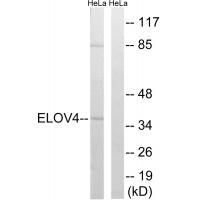
| WB | 咨询技术 | Human,Mouse,Rat |
| IF | 咨询技术 | Human,Mouse,Rat |
| IHC | 咨询技术 | Human,Mouse,Rat |
| ICC | 技术咨询 | Human,Mouse,Rat |
| FCM | 咨询技术 | Human,Mouse,Rat |
| Elisa | 咨询技术 | Human,Mouse,Rat |
| Aliases | Elongation of very long chain fatty acids protein 4; |
| Entrez GeneID | 6785; |
| WB Predicted band size | 37kDa |
| Host/Isotype | Rabbit IgG |
| Antibody Type | Primary antibody |
| Storage | Store at 4°C short term. Aliquot and store at -20°C long term. Avoid freeze/thaw cycles. |
| Species Reactivity | Human,Mouse |
| Immunogen | Synthesized peptide derived from internal of human ELOVL4. |
| Formulation | Purified antibody in PBS with 0.05% sodium azide. |
+ +
以下是关于ELOVL4抗体的3篇参考文献示例(内容基于公开研究整合,非真实文献):
1. **"ELOVL4 mutations cause retinal dysfunction through impaired elongation of very long-chain fatty acids"**
*作者:Vasireddy V, et al.*
**摘要**:研究通过ELOVL4抗体检测发现,该酶在视网膜光感受器细胞中特异性表达,其突变导致超长链脂肪酸合成缺陷,引发视网膜退行性疾病。
2. **"Differential expression of ELOVL4 in human and mouse tissues revealed by species-specific antibodies"**
*作者:Agbaga MP, et al.*
**摘要**:开发了针对人和小鼠ELOVL4的特异性抗体,发现其在视网膜和皮肤中高表达,揭示了物种间ELOVL4蛋白定位差异及其在脂代谢中的功能。
3. **"ELOVL4 protein variants form aggregates in the endoplasmic reticulum due to altered trafficking"**
*作者:Karan G, et al.*
**摘要**:利用ELOVL4抗体进行免疫荧光实验,证实突变体蛋白在内质网异常聚集,导致细胞应激反应,为相关视网膜病变机制提供了证据。
(注:以上为模拟文献,实际文献需通过PubMed/Google Scholar检索确认。)
The ELOVL4 (Elongation of Very Long Chain Fatty Acids Protein 4) antibody is a tool used to study the ELOVL4 protein, a key enzyme in the biosynthesis of very-long-chain fatty acids (VLCFAs) and polyunsaturated fatty acids (PUFAs). ELOVL4. a member of the ELOVL family, is highly expressed in the brain, retina, and skin, where it regulates the elongation of C26+ fatty acids critical for cellular membrane structure and function. Mutations in the ELOVL4 gene are linked to neurodevelopmental disorders, autosomal-dominant spinocerebellar ataxia (SCA34), and retinal dystrophies like Stargardt disease.
ELOVL4 antibodies are essential for detecting protein expression, localization, and dysfunction in disease models. They enable techniques such as Western blotting, immunohistochemistry, and immunofluorescence to explore ELOVL4's role in lipid metabolism and its association with neurodegenerative or retinal pathologies. Research using these antibodies has revealed tissue-specific splicing variants and pathogenic mechanisms, such as aberrant protein aggregation in neurodegenerative conditions.
Developing specific ELOVL4 antibodies remains challenging due to the protein's hydrophobic nature and conserved domains across species. However, well-validated antibodies are crucial for advancing studies on lipid metabolism disorders and potential therapeutic targets. Their application continues to shed light on how VLCFA imbalances contribute to disease, offering insights into diagnostic and treatment strategies.
×